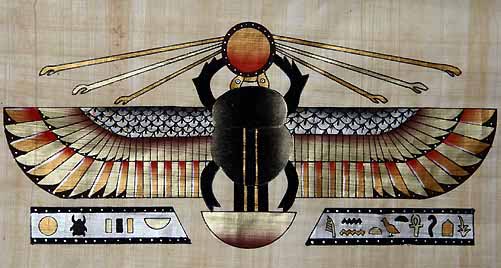

The winged scarab symbolized self-creation or rebirth. This potent symbolism appears in tomb paintings, manuscripts, hieroglyphic inscriptions on buildings and carvings. In addition to its use as an amulet for the living and the dead, scarabs adorned jewelry including necklaces, bracelets, wrist cuffs and wide decorative collars. A bracelet from the tomb of Tutankhamun featured a bright blue scarab holding a cartouche between its front legs. A cartouche is an oval frame that encloses a name. The ancient Egyptians sometimes painted or carved scarabs on a deceased person's sarcophagus, the human-shaped coffin that held the mummy. Scarabs often hold a sun disk over their heads.
Scarabs were popular amulets in ancient Egypt. According to ancient Egyptian myths, the sun (Ra) rolls across the sky each day and transforms bodies and souls. Modeled upon the Scarabaeidae family dung beetle, which rolls dung into a ball for the purposes of eating and laying eggs that are later transformed into larva, the scarab was seen as an earthly symbol of this heavenly cycle. This came to be iconographic, and ideological symbols were incorporated into ancient Egyptian society.
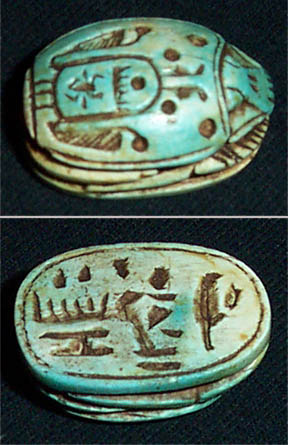
Through different time periods, about 3000 years, the use of the scarabs became many and varied. As amulets, and a flat surface on the bottom (as a similar artifact of a paperweight), it became a surface with other utilitarian purposes. Other nations and regions, especially in the Levant, even came to reproduce Egyptian styles, or to adapt their use to their own gods or personal uses. They were also found as grave goods, amulets, talismans, jewelry types, or gifts of affection.
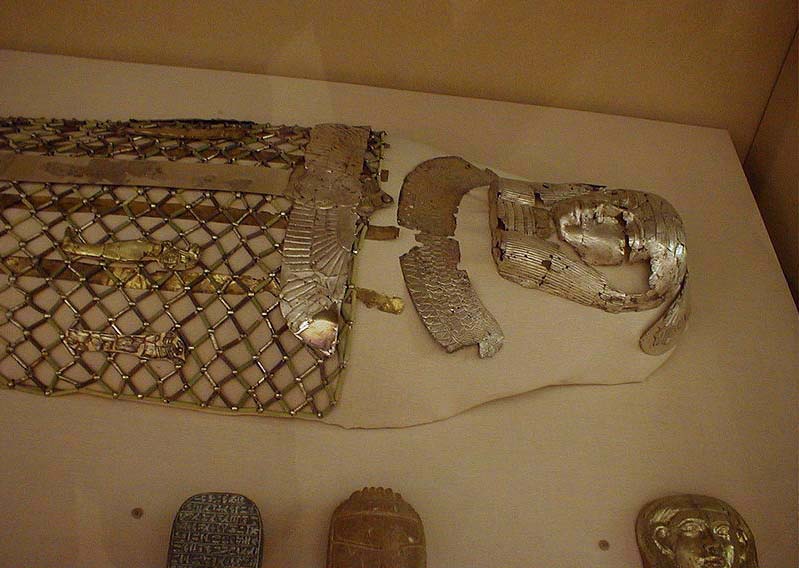
Queen Mernua's coffin has two large scarabs beside, one showing hieroglyphs on bottom. Beginning in the Old Kingdom of ancient Egypt, memorializing scarabs became common. They were often incorporated into tombs, as grave goods, or given as 'gifts'.
Amenhotep III is famous for his commemorative scarabs that memorialized events of his day. A type of these relates to his lion hunts in the first 10 years of his reign (with claims of extraordinary lion numbers); others of the series relates the building of 'the lake for his wife, Queen Tiye parents of Akhenaten.
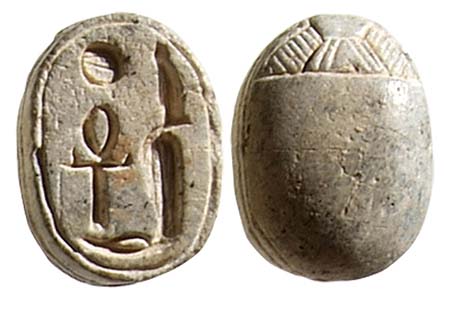
Miniature scarab seals were carried, or kept in the later periods of Ancient Egypt. They often had "catch phrases"; for example: "A mun-my-Strength". (A mun-my-Rock). To the ancient Egyptians, the scarab or dung beetle was a protector of written products. The scarab was also used as a holder or medium for personal name seals. A figurine of a scarab would be carved out of stone, and then on the smooth stomach of the scarab, the engraving of a seal was made. Later, this oval image was used for the representation of the cartouche, or name/title seals.

Sumerian Cylinder Seals
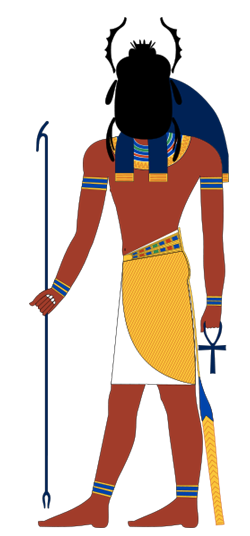
Khepri
Sun-god creator in the form of a scarab beetle
Like Atum, Khephir was a self-created god. The scarab lays its eggs in a ball of dung and rolls it to hide in a safe place. From this unlikely substance the Egyptians observed new life emerging, seemingly from the Earth. Hence he was a god of creation. Early in Egyptian history the beetle also came to represent the soul rising from death - resurrected, transcendent, fully formed and ready to make its journey and face its judgment in order to live in the Afterlife. By the New Kingdom (1539-1070 BC), the funerary texts from the papyri portray a scaraboid form as the most powerful symbol of life's victory over death.
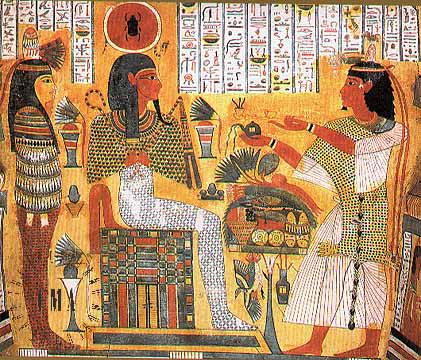
The dung beetle is painted in the red orb. It identifies
the seated figure as the god of the morning sun, Khepri.
The hieroglyphs to the right of the seated figure;
they also identify him as Atum, the evening sun.
The painted symbol of the dung beetle and the inscription
tell us the figure represents the sun god that rises in the
east and sets in the west.
The mummy of the Priestess Nesykhonsu standing to the left
of the sun god. This painting is from the inside of her coffin.
The Priest at the right makes offerings to the sun god.
The scarab was based on the image of the dung beetle, or Scarabeus Sacer, and it was used by the ancient Egyptians for many purposes such as recording historical events or inscribing prayers to be placed on mummies for protection against evil.
Scarabs were also used as seals by officials. The writing would be inscribed on the base (flat side) of the scarab, and sizes varied from several centimeters to several meters long. It was not really until Pharaoh Amenhotep III's reign that the scarabs were made extra large - up to 2.5 metres long in the Karnak Temple.
Scarabs were made from a wide variety of materials such as carnelian, lapis lazuli, basalt, limestone, schist, turquoise, ivory, resin, steatite, and bronze. Most scarabs were made of steatite which was then covered with a turquoise colored glaze. The stone was soft and easy to work, but when glazed, it became hard and durable.
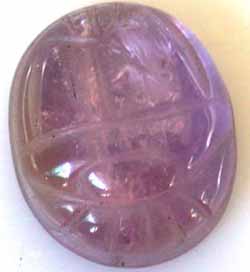
In the 12th dynasty, amethyst was used for the first time. Gold and silver scarabs have also been found, but are much rarer, because of grave robbers. The Greeks used onyx, agate, and quartz in making their scarabs. These materials were not used in Egypt until the Ptolemaic period, when Greek influence on Egyptian life was at a peak. The Greeks also had more advanced technology in some areas and could therefore work hard materials with greater ease than the Egyptians could.
Heart scarabs were placed next to the heart after the body was mummified. The scarabs were usually made of green stone, and could range in size from 3 to 10 cm. On almost all of the scarabs, chapter 30B from the Book of the Dead was inscribed.
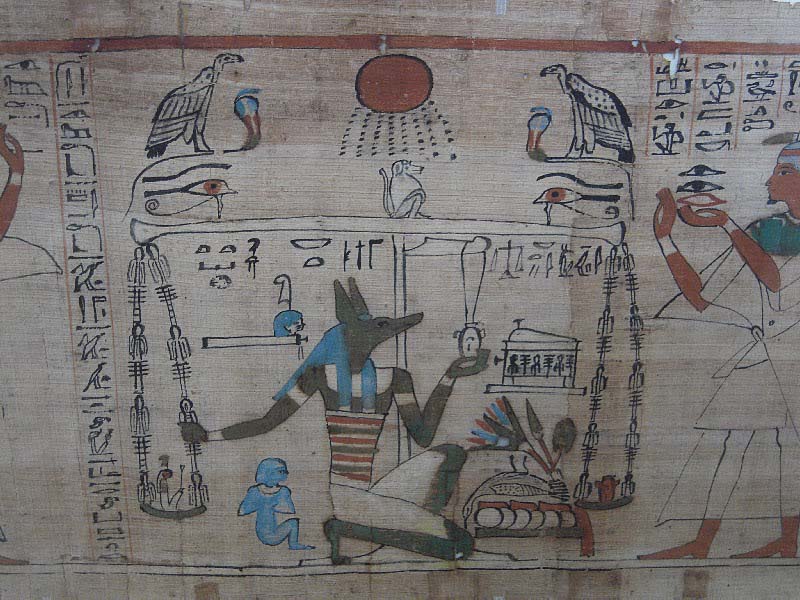
In this chapter, the dead person asks his heart not to testify against him during the Weighing of The Heart Ceremony whether he has committed a sin or not. In other cases, heart scarabs were used for just general protection from evil during the journey to the Afterlife.
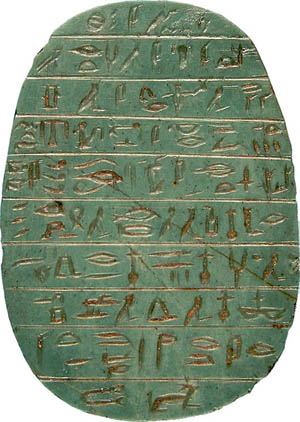
Heart scarabs were always made of some green material, usually green jasper. This stone is actually quite rare and difficult to cut, so in many cases other types of rock were used as substitutes, for example green feldspar, basalt, and serpentine. The reason why green was used was that it symbolized resurrection and health.
The Phoenicians lived in the area which we now call Lebanon and the Egyptians had a very strong bond with these people both politically and commercially. After some time the Egyptians started to influence the Phoenician culture, bringing the scarab into their art.
The first scarab from Phoenicia was made in the 8th century BC (approximately the 23rd dynasty). As the Phoenicians themselves were clever traders and possessed several colonies, they spread the scarab throughout the Mediterranean, bringing it to all major ports along their trade routes. The Greeks started using the scarab as well, and as a result, the scarab made it onto mainland Europe, into areas where the dung beetle had never lived.
The Greeks settled in Etruria in the mid-sixth century BC. They soon started to influence the Etruscans the native civilization of Etruria. The Greeks taught them how to make scarabs, but the Etruscans did not use the scarab as a seal. Instead they used them for ornamentation in everyday life.
As the scarab traveled throughout Europe and Asia by trade, war and politics, its purpose changed. Originally used as a symbol for birth and rebirth, it quickly evolved to becoming an amulet for protective purposes used in many completely different religions, a seal for officials and later only for decorative purposes.
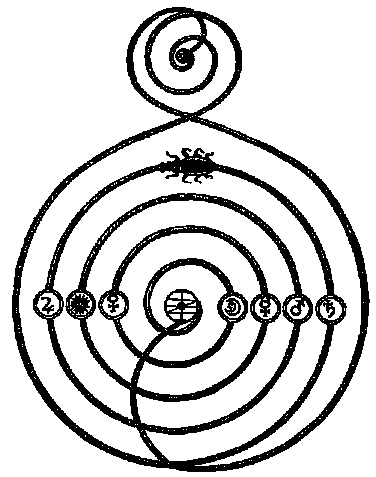
A dung beetle named Aksak made the first
woman and man on Earth out of clay.
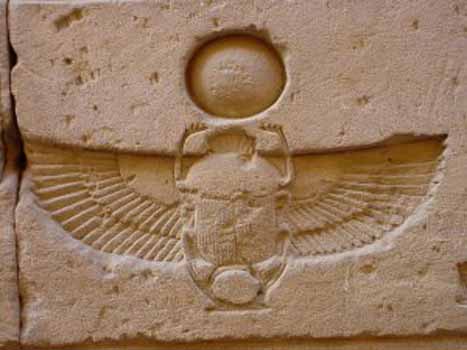
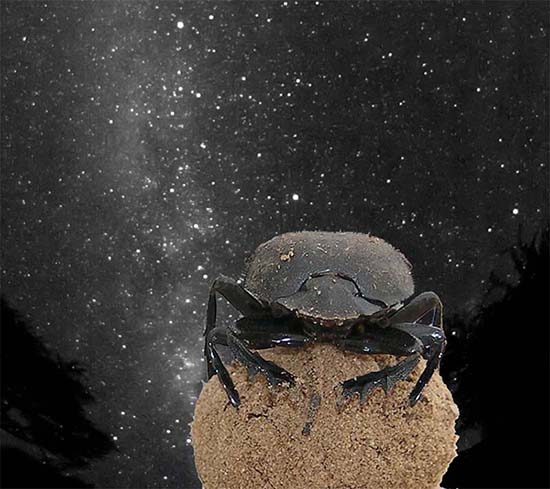
Dung Beetles, Scarabs, and the Milky Way Galaxy